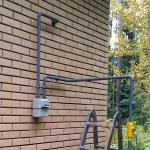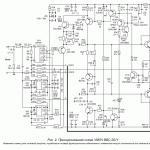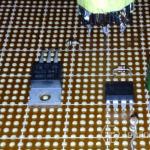Modern realities involve the widespread operation of heat engines. Numerous attempts to replace them with electric motors have so far failed. The problems associated with the accumulation of electricity in autonomous systems are solved with great difficulty.
Still relevant are the problems of technology for the manufacture of electric power accumulators, taking into account their long-term use. The speed characteristics of electric vehicles are far from those of cars on internal combustion engines.
The first steps towards the creation of hybrid engines can significantly reduce harmful emissions in megacities, solving environmental problems.
A bit of history
The possibility of converting steam energy into motion energy was known in antiquity. 130 BC: The philosopher Heron of Alexandria presented to the audience a steam toy - aeolipil. A sphere filled with steam began to rotate under the action of jets emanating from it. This prototype of modern steam turbines did not find application in those days.
For many years and centuries, the development of the philosopher was considered only a fun toy. In 1629, the Italian D. Branchi created an active turbine. Steam set in motion a disk equipped with blades.
From that moment began the rapid development of steam engines.
heat engine

The conversion of fuel into energy for the movement of parts of machines and mechanisms is used in heat engines.
The main parts of machines: a heater (a system for obtaining energy from outside), a working fluid (performs a useful action), a refrigerator.
The heater is designed to ensure that the working fluid has accumulated a sufficient supply of internal energy to perform useful work. The refrigerator removes excess energy.
The main characteristic of efficiency is called the efficiency of heat engines. This value shows what part of the energy spent on heating is spent on doing useful work. The higher the efficiency, the more profitable the operation of the machine, but this value cannot exceed 100%.
Efficiency calculation
Let the heater acquire from outside the energy equal to Q 1 . The working fluid did work A, while the energy given to the refrigerator was Q 2 .
Based on the definition, we calculate the efficiency:
η= A / Q 1 . We take into account that A \u003d Q 1 - Q 2.
From here, the efficiency of the heat engine, the formula of which has the form η = (Q 1 - Q 2) / Q 1 = 1 - Q 2 / Q 1, allows us to draw the following conclusions:
- Efficiency cannot exceed 1 (or 100%);
- to maximize this value, either an increase in the energy received from the heater or a decrease in the energy given to the refrigerator is necessary;
- an increase in the energy of the heater is achieved by changing the quality of the fuel;
- reducing the energy given to the refrigerator, make it possible to achieve the design features of the engines.

Ideal heat engine
Is it possible to create such an engine, the efficiency of which would be maximum (ideally, equal to 100%)? The French theoretical physicist and talented engineer Sadi Carnot tried to find the answer to this question. In 1824, his theoretical calculations about the processes occurring in gases were made public.
The main idea behind an ideal machine is to carry out reversible processes with an ideal gas. We start with the expansion of the gas isothermally at a temperature T 1 . The amount of heat required for this is Q 1. After the gas expands without heat exchange. Having reached the temperature T 2, the gas is compressed isothermally, transferring the energy Q 2 to the refrigerator. The return of the gas to its original state is adiabatic.
The efficiency of an ideal Carnot heat engine, when accurately calculated, is equal to the ratio of the temperature difference between the heating and cooling devices to the temperature that the heater has. It looks like this: η=(T 1 - T 2)/ T 1.
The possible efficiency of a heat engine, the formula of which is: η= 1 - T 2 / T 1 , depends only on the temperature of the heater and cooler and cannot be more than 100%.
Moreover, this ratio allows us to prove that the efficiency of heat engines can be equal to unity only when the refrigerator reaches temperatures. As you know, this value is unattainable.
Carnot's theoretical calculations make it possible to determine the maximum efficiency of a heat engine of any design.
The theorem proved by Carnot is as follows. An arbitrary heat engine under no circumstances is capable of having a coefficient of efficiency greater than the similar value of the efficiency of an ideal heat engine.

Example of problem solving
Example 1 What is the efficiency of an ideal heat engine if the heater temperature is 800°C and the refrigerator temperature is 500°C lower?
T 1 \u003d 800 o C \u003d 1073 K, ∆T \u003d 500 o C \u003d 500 K, η -?
By definition: η=(T 1 - T 2)/ T 1.
We are not given the temperature of the refrigerator, but ∆T = (T 1 - T 2), from here:
η \u003d ∆T / T 1 \u003d 500 K / 1073 K \u003d 0.46.
Answer: efficiency = 46%.
Example 2 Determine the efficiency of an ideal heat engine if 650 J of useful work is performed due to the acquired one kilojoule of heater energy. What is the temperature of the heat engine heater if the coolant temperature is 400 K?
Q 1 \u003d 1 kJ \u003d 1000 J, A \u003d 650 J, T 2 \u003d 400 K, η -?, T 1 \u003d?
In this problem, we are talking about a thermal installation, the efficiency of which can be calculated by the formula:
To determine the temperature of the heater, we use the formula for the efficiency of an ideal heat engine:
η \u003d (T 1 - T 2) / T 1 \u003d 1 - T 2 / T 1.
After performing mathematical transformations, we get:
T 1 \u003d T 2 / (1- η).
T 1 \u003d T 2 / (1- A / Q 1).
Let's calculate:
η= 650 J / 1000 J = 0.65.
T 1 \u003d 400 K / (1- 650 J / 1000 J) \u003d 1142.8 K.
Answer: η \u003d 65%, T 1 \u003d 1142.8 K.
Real conditions
The ideal heat engine is designed with ideal processes in mind. Work is done only in isothermal processes, its value is defined as the area bounded by the Carnot cycle graph.

In fact, it is impossible to create conditions for the process of changing the state of a gas without accompanying changes in temperature. There are no materials that would exclude heat exchange with surrounding objects. The adiabatic process is no longer possible. In the case of heat transfer, the temperature of the gas must necessarily change.
The efficiency of heat engines created in real conditions differ significantly from the efficiency of ideal engines. Note that the processes in real engines are so fast that the variation in the internal thermal energy of the working substance in the process of changing its volume cannot be compensated by the influx of heat from the heater and return to the cooler.
Other heat engines
Real engines operate on different cycles:
- Otto cycle: the process at a constant volume changes adiabatically, creating a closed cycle;
- Diesel cycle: isobar, adiabat, isochor, adiabat;
- the process occurring at constant pressure is replaced by an adiabatic one, closing the cycle.
It is not possible to create equilibrium processes in real engines (to bring them closer to ideal ones) under the conditions of modern technology. The efficiency of thermal engines is much lower, even taking into account the same temperature regimes as in an ideal thermal installation.
But you should not reduce the role of the efficiency calculation formula, since it is it that becomes the starting point in the process of working to increase the efficiency of real engines.
Ways to change efficiency
When comparing ideal and real heat engines, it is worth noting that the temperature of the refrigerator of the latter cannot be any. Usually the atmosphere is considered to be a refrigerator. The temperature of the atmosphere can be taken only in approximate calculations. Experience shows that the temperature of the coolant is equal to the temperature of the exhaust gases in the engines, as is the case in internal combustion engines (abbreviated internal combustion engines).

ICE is the most common heat engine in our world. The efficiency of a heat engine in this case depends on the temperature created by the burning fuel. An essential difference between an internal combustion engine and steam engines is the merging of the functions of the heater and the working fluid of the device in the air-fuel mixture. Burning, the mixture creates pressure on the moving parts of the engine.
An increase in the temperature of the working gases is achieved by significantly changing the properties of the fuel. Unfortunately, it is not possible to do this indefinitely. Any material from which the combustion chamber of an engine is made has its own melting point. The heat resistance of such materials is the main characteristic of the engine, as well as the ability to significantly affect the efficiency.
Motor efficiency values
If we consider the temperature of the working steam at the inlet of which is 800 K, and the exhaust gas is 300 K, then the efficiency of this machine is 62%. In reality, this value does not exceed 40%. Such a decrease occurs due to heat losses during heating of the turbine housing.

The highest value of internal combustion does not exceed 44%. Increasing this value is a matter of the near future. Changing the properties of materials, fuels is a problem that the best minds of mankind are working on.
Coefficient of performance (COP) - a term that can be applied, perhaps, to every system and device. Even a person has an efficiency, though, probably, there is no objective formula for finding it yet. In this article, we will explain in detail what efficiency is and how it can be calculated for various systems.
efficiency definition
Efficiency is an indicator that characterizes the efficiency of a particular system in relation to the return or conversion of energy. Efficiency is a measureless value and is represented either as a numerical value in the range from 0 to 1, or as a percentage.
General formula
Efficiency is indicated by the symbol Ƞ.
The general mathematical formula for finding the efficiency is written as follows:
Ƞ=A/Q, where A is the useful energy/work done by the system, and Q is the energy consumed by this system to organize the process of obtaining a useful output.
The efficiency factor, unfortunately, is always less than one or equal to it, since, according to the law of conservation of energy, we cannot get more work than the energy spent. In addition, the efficiency, in fact, is extremely rarely equal to one, since useful work is always accompanied by losses, for example, for heating the mechanism.
Heat engine efficiency
A heat engine is a device that converts thermal energy into mechanical energy. In a heat engine, work is determined by the difference between the amount of heat received from the heater and the amount of heat given to the cooler, and therefore the efficiency is determined by the formula:
- Ƞ=Qн-Qх/Qн, where Qн is the amount of heat received from the heater, and Qх is the amount of heat given to the cooler.
It is believed that the highest efficiency is provided by engines operating on the Carnot cycle. In this case, the efficiency is determined by the formula:
- Ƞ=T1-T2/T1, where T1 is the temperature of the hot source, T2 is the temperature of the cold source.
Electric motor efficiency
An electric motor is a device that converts electrical energy into mechanical energy, so the efficiency in this case is the efficiency ratio of the device in relation to the conversion of electrical energy into mechanical energy. The formula for finding the efficiency of an electric motor looks like this:
- Ƞ=P2/P1, where P1 is the supplied electrical power, P2 is the useful mechanical power generated by the engine.
Electrical power is found as the product of system current and voltage (P=UI), and mechanical power is found as the ratio of work to unit time (P=A/t)
transformer efficiency
A transformer is a device that converts alternating current of one voltage into alternating current of another voltage while maintaining frequency. In addition, transformers can also convert AC to DC.
The efficiency of the transformer is found by the formula:
- Ƞ=1/1+(P0+PL*n2)/(P2*n), where P0 - no-load losses, PL - load losses, P2 - active power delivered to the load, n - relative degree of loading.
Efficiency or not efficiency?
It is worth noting that in addition to efficiency, there are a number of indicators that characterize the efficiency of energy processes, and sometimes we can find descriptions of the type - efficiency of the order of 130%, however, in this case, you need to understand that the term is not used quite correctly, and, most likely, the author or the manufacturer understands a slightly different characteristic by this abbreviation.
For example, heat pumps are distinguished by the fact that they can give off more heat than they consume. Thus, the refrigerating machine can remove more heat from the cooled object than is spent in energy equivalent for the organization of the removal. The efficiency indicator of a refrigerating machine is called the coefficient of performance, denoted by the letter Ɛ and is determined by the formula: Ɛ=Qx/A, where Qx is the heat removed from the cold end, A is the work expended on the removal process. However, sometimes the coefficient of performance is also called the efficiency of the refrigeration machine.
It is also interesting that the efficiency of boilers running on fossil fuels is usually calculated on the basis of the lower calorific value, while it can turn out to be more than one. However, it is still traditionally referred to as efficiency. It is possible to determine the efficiency of the boiler by the gross calorific value, and then it will always be less than one, but in this case it will be inconvenient to compare the performance of the boilers with the data of other installations.
The operation of many types of machines is characterized by such an important indicator as the efficiency of a heat engine. Every year, engineers strive to create more advanced equipment that, at lower fuel costs, would give the maximum result from its use.
Heat engine device
Before understanding what efficiency is (coefficient of performance), it is necessary to understand how this mechanism works. Without knowing the principles of its action, it is impossible to find out the essence of this indicator. A heat engine is a device that does work by using internal energy. Any heat engine that converts thermal energy into mechanical energy uses the thermal expansion of substances with increasing temperature. In solid-state engines, it is possible not only to change the volume of matter, but also the shape of the body. The operation of such an engine is subject to the laws of thermodynamics.
Operating principle
In order to understand how a heat engine works, it is necessary to consider the basics of its design. For the operation of the device, two bodies are needed: hot (heater) and cold (refrigerator, cooler). The principle of operation of heat engines (the efficiency of heat engines) depends on their type. Often, the steam condenser acts as a refrigerator, and any type of fuel that burns in the furnace acts as a heater. The efficiency of an ideal heat engine is found by the following formula:
Efficiency = (Theating - Tcold.) / Theating. x 100%.
At the same time, the efficiency of a real engine can never exceed the value obtained according to this formula. Also, this indicator will never exceed the above value. To increase the efficiency, most often increase the temperature of the heater and reduce the temperature of the refrigerator. Both of these processes will be limited by the actual operating conditions of the equipment.

During the operation of a heat engine, work is done, as the gas begins to lose energy and cools to a certain temperature. The latter is usually a few degrees above the surrounding atmosphere. This is the refrigerator temperature. Such a special device is designed for cooling with subsequent condensation of the exhaust steam. Where condensers are present, the temperature of the refrigerator is sometimes lower than the ambient temperature.
In a heat engine, the body, when heated and expanded, is not able to give all its internal energy to do work. Some of the heat will be transferred to the refrigerator along with exhaust gases or steam. This part of the thermal internal energy is inevitably lost. During the combustion of fuel, the working fluid receives a certain amount of heat Q 1 from the heater. At the same time, it still does work A, during which it transfers part of the thermal energy to the refrigerator: Q 2 Efficiency characterizes the efficiency of the engine in the field of energy conversion and transmission. This indicator is often measured as a percentage. Efficiency formula: η*A/Qx100%, where Q is the expended energy, A is useful work. Based on the law of conservation of energy, we can conclude that the efficiency will always be less than unity. In other words, there will never be more useful work than the energy expended on it. Engine efficiency is the ratio of useful work to the energy supplied by the heater. It can be represented as the following formula: η \u003d (Q 1 -Q 2) / Q 1, where Q 1 is the heat received from the heater, and Q 2 is given to the refrigerator. The work done by a heat engine is calculated by the following formula: A = |Q H | - |Q X |, where A is work, Q H is the amount of heat received from the heater, Q X is the amount of heat given to the cooler. |Q H | - |Q X |)/|Q H | = 1 - |Q X |/|Q H | It is equal to the ratio of the work done by the engine to the amount of heat received. Part of the thermal energy is lost during this transfer. The maximum efficiency of a heat engine is noted for the Carnot device. This is due to the fact that in this system it depends only on the absolute temperature of the heater (Тн) and cooler (Тх). The efficiency of a heat engine operating according to the Carnot cycle is determined by the following formula: (Tn - Tx) / Tn = - Tx - Tn. Nowadays, there are many types of heat engines that operate on different principles and on different fuels. They all have their own efficiency. These include the following: An internal combustion engine (piston), which is a mechanism where part of the chemical energy of the burning fuel is converted into mechanical energy. Such devices can be gas and liquid. There are 2-stroke and 4-stroke engines. They may have a continuous duty cycle. According to the method of preparing the fuel mixture, such engines are carburetor (with external mixture formation) and diesel (with internal). According to the types of energy converter, they are divided into piston, jet, turbine, combined. The efficiency of such machines does not exceed 0.5. Stirling engine - a device in which the working fluid is in a closed space. It is a kind of external combustion engine. The principle of its operation is based on periodic cooling/heating of the body with the production of energy due to a change in its volume. This is one of the most efficient engines. Turbine (rotary) engine with external combustion of fuel. Such installations are most often found in thermal power plants. Turbine (rotary) internal combustion engines are used at thermal power plants in peak mode. Not as common as others. A turboprop engine generates some of the thrust due to the propeller. The rest comes from exhaust gases. Its design is a rotary engine (gas turbine), on the shaft of which a propeller is mounted. Rocket, turbojet and jet engines that obtain thrust from the return of exhaust gases. Solid state engines use a solid body as fuel. When working, it is not its volume that changes, but its shape. During operation of the equipment, an extremely small temperature difference is used. Is it possible to increase the efficiency of a heat engine? The answer must be sought in thermodynamics. It studies the mutual transformations of different types of energy. It has been established that it is impossible to convert all available thermal energy into electrical, mechanical, etc. At the same time, their conversion into thermal energy occurs without any restrictions. This is possible due to the fact that the nature of thermal energy is based on the disordered (chaotic) movement of particles. The more the body heats up, the faster the molecules that make it up will move. Particle motion will become even more erratic. Along with this, everyone knows that order can be easily turned into chaos, which is very difficult to order. The main significance of the formula (5.12.2) obtained by Carnot for the efficiency of an ideal machine is that it determines the maximum possible efficiency of any heat engine. Carnot proved, based on the second law of thermodynamics*, the following theorem: any real heat engine operating with a temperature heaterT
1
and refrigerator temperatureT
2
, cannot have an efficiency exceeding the efficiency of an ideal heat engine. * Carnot actually established the second law of thermodynamics before Clausius and Kelvin, when the first law of thermodynamics had not yet been formulated rigorously. Consider first a heat engine operating on a reversible cycle with a real gas. The cycle can be any, it is only important that the temperatures of the heater and refrigerator are T 1
And T 2
.
Let us assume that the efficiency of another heat engine (not operating according to the Carnot cycle) η ’
>
η .
The machines work with a common heater and a common cooler. Let the Carnot machine work in the reverse cycle (like a refrigeration machine), and the other machine in the forward cycle (Fig. 5.18). The heat engine performs work equal, according to formulas (5.12.3) and (5.12.5): The refrigeration machine can always be designed so that it takes the amount of heat from the refrigerator Q 2
= | Then, according to formula (5.12.7), work will be performed on it Since by condition η" > η ,
That A" > A. Therefore, the heat engine can drive the refrigeration engine, and there will still be an excess of work. This excess work is done at the expense of heat taken from one source. After all, heat is not transferred to the refrigerator under the action of two machines at once. But this contradicts the second law of thermodynamics. If we assume that η > η ",
then you can make another machine work in a reverse cycle, and Carnot's machine in a straight line. We again come to a contradiction with the second law of thermodynamics. Therefore, two machines operating on reversible cycles have the same efficiency: η "
=
η .
It is a different matter if the second machine operates in an irreversible cycle. If we allow η "
>
η ,
then we again come to a contradiction with the second law of thermodynamics. However, the assumption m|"< г| не противоречит второму закону
термодинамики, так как необратимая
тепловая машина не может работать как
холодильная машина. Следовательно, КПД
любой тепловой машины η"
≤ η, or This is the main result: Formula (5.12.13) gives the theoretical limit for the maximum efficiency of heat engines. It shows that the heat engine is more efficient, the higher the temperature of the heater and the lower the temperature of the refrigerator. Only when the refrigerator temperature is equal to absolute zero, η = 1. But the temperature of the refrigerator practically cannot be much lower than the ambient temperature. You can increase the temperature of the heater. However, any material (solid) has limited heat resistance, or heat resistance. When heated, it gradually loses its elastic properties, and melts at a sufficiently high temperature. Now the main efforts of engineers are aimed at increasing the efficiency of engines by reducing the friction of their parts, fuel losses due to its incomplete combustion, etc. The real opportunities for increasing the efficiency here are still large. So, for a steam turbine, the initial and final steam temperatures are approximately as follows: T 1
=
800 K and T 2
=
300 K. At these temperatures, the maximum value of the efficiency is: The actual value of the efficiency due to various kinds of energy losses is approximately 40%. The maximum efficiency - about 44% - have internal combustion engines. The efficiency of any heat engine cannot exceed the maximum possible value Increasing the efficiency of heat engines and bringing it closer to the maximum possible-
the most important technical challenge. slide 1 slide 2 slide 3 slide 4 slide 5 slide 6 Slide 7 Slide 8 Slide 9Heat engine operation

Carnot engine
 The laws of thermodynamics made it possible to calculate the maximum efficiency that is possible. For the first time this indicator was calculated by the French scientist and engineer Sadi Carnot. He invented a heat engine that ran on ideal gas. It works on a cycle of 2 isotherms and 2 adiabats. The principle of its operation is quite simple: a heater contact is brought to the vessel with gas, as a result of which the working fluid expands isothermally. At the same time, it functions and receives a certain amount of heat. After the vessel is thermally insulated. Despite this, the gas continues to expand, but already adiabatically (without heat exchange with the environment). At this time, its temperature drops to the refrigerator. At this moment, the gas is in contact with the refrigerator, as a result of which it gives it a certain amount of heat during isometric compression. Then the vessel is again thermally insulated. In this case, the gas is adiabatically compressed to its original volume and state.
The laws of thermodynamics made it possible to calculate the maximum efficiency that is possible. For the first time this indicator was calculated by the French scientist and engineer Sadi Carnot. He invented a heat engine that ran on ideal gas. It works on a cycle of 2 isotherms and 2 adiabats. The principle of its operation is quite simple: a heater contact is brought to the vessel with gas, as a result of which the working fluid expands isothermally. At the same time, it functions and receives a certain amount of heat. After the vessel is thermally insulated. Despite this, the gas continues to expand, but already adiabatically (without heat exchange with the environment). At this time, its temperature drops to the refrigerator. At this moment, the gas is in contact with the refrigerator, as a result of which it gives it a certain amount of heat during isometric compression. Then the vessel is again thermally insulated. In this case, the gas is adiabatically compressed to its original volume and state.Varieties
Other types of heat engines

How can you increase efficiency


 |
| (5.12.12)
(5.12.12)
 (5.12.13)
(5.12.13)Efficiency of real heat engines

 ,
where T 1
-
absolute temperature of the heater, and T 2
-
absolute temperature of the refrigerator.
,
where T 1
-
absolute temperature of the heater, and T 2
-
absolute temperature of the refrigerator. The task is to determine the efficiency factor according to the graph of pressure versus volume. Calculate the efficiency of a heat engine using a monatomic ideal gas as a working fluid and operating according to the cycle shown in the figure. The appearance of new drawings and records occurs only after a mouse click.
The task is to determine the efficiency factor according to the graph of pressure versus volume. Calculate the efficiency of a heat engine using a monatomic ideal gas as a working fluid and operating according to the cycle shown in the figure. The appearance of new drawings and records occurs only after a mouse click.
 The task is to determine the efficiency factor according to the graph of pressure versus volume. Calculate the efficiency of a heat engine using a monatomic ideal gas as a working fluid and operating according to the cycle shown in the figure.
The task is to determine the efficiency factor according to the graph of pressure versus volume. Calculate the efficiency of a heat engine using a monatomic ideal gas as a working fluid and operating according to the cycle shown in the figure.
 Hint No. 1 Therefore, it is necessary to determine in each process the amount of heat received or given out by changing the temperature. Calculation of the amount of heat produced on the basis of the first law of thermodynamics.
Hint No. 1 Therefore, it is necessary to determine in each process the amount of heat received or given out by changing the temperature. Calculation of the amount of heat produced on the basis of the first law of thermodynamics.
 Hint #2 The work done in any process is numerically equal to the area of the figure enclosed under the graph in P(V) coordinates. The area of the shaded figure is equal to the work in the 2-3 process, and the area of the shaded figure is equal to the work in the 4-1 process, and it is this gas work that is negative, since from 4 to 1 the volume decreases. Work per cycle is equal to the sum of these works. Therefore, the work of the gas per cycle is numerically equal to the area of this cycle.
Hint #2 The work done in any process is numerically equal to the area of the figure enclosed under the graph in P(V) coordinates. The area of the shaded figure is equal to the work in the 2-3 process, and the area of the shaded figure is equal to the work in the 4-1 process, and it is this gas work that is negative, since from 4 to 1 the volume decreases. Work per cycle is equal to the sum of these works. Therefore, the work of the gas per cycle is numerically equal to the area of this cycle.
 Algorithm for solving the problem. 1. Write down the efficiency formula. 2. Determine the work of the gas by the area of the process figure in the coordinates P,V. 3. Analyze in which of the processes the amount of heat is absorbed and not released. 4. Using the 1st law of thermodynamics, calculate the amount of heat received. 5. Calculate the efficiency.
Algorithm for solving the problem. 1. Write down the efficiency formula. 2. Determine the work of the gas by the area of the process figure in the coordinates P,V. 3. Analyze in which of the processes the amount of heat is absorbed and not released. 4. Using the 1st law of thermodynamics, calculate the amount of heat received. 5. Calculate the efficiency.
 1. Write down the efficiency formula. 2. Determine the work of the gas by the area of the process figure in the coordinates P,V. Solution
1. Write down the efficiency formula. 2. Determine the work of the gas by the area of the process figure in the coordinates P,V. Solution
 1. Process1 -2. V = const, P T Q is absorbed 2. Process 2 – 3. P = const, V , T Q is absorbed 3. Process 3 – 4. V = const, P , T Q is extracted 4. Process 4 – 1. P = const, V , T Q 3. Analyze in which of the processes the amount of heat is absorbed rather than released.
1. Process1 -2. V = const, P T Q is absorbed 2. Process 2 – 3. P = const, V , T Q is absorbed 3. Process 3 – 4. V = const, P , T Q is extracted 4. Process 4 – 1. P = const, V , T Q 3. Analyze in which of the processes the amount of heat is absorbed rather than released.
 For process 1-2 4. Using the 1st law of thermodynamics, calculate the amount of heat received. hence For an isochoric process Subtract the upper equation from the lower equation
For process 1-2 4. Using the 1st law of thermodynamics, calculate the amount of heat received. hence For an isochoric process Subtract the upper equation from the lower equation


















